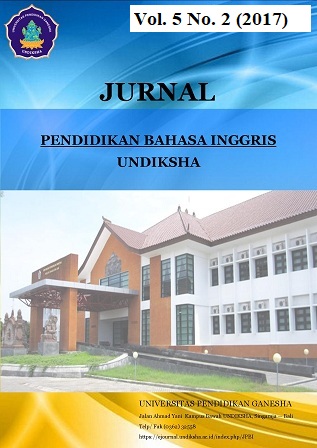THE ANALYSIS OF SWEAR WORDS USED BY THE TEENAGERS IN NUSA PENIDA
DOI:
https://doi.org/10.23887/jpbi.v5i2.15254Abstract
Penelitian ini bertujuan untuk menganalisis kata-kata umpatan yang digunakan oleh remaja di Nusa Penida. Penelitian ini menggunakan penelitian deskriptif kualitatif yang dilakukan dengan mengamati, merekam audio, dan mewawancarai para informan. Informan adalah 16 remaja yang berasal dari Nusa Penida. Hasil penelitian menunjukkan bahwa kata-kata umpatan yang digunakan oleh remaja di Nusa Penida memiliki bentuk, referensi, dan fungsi. Terdapat tiga bentuk kata-kata makian: (1) dalam bentuk kata yang dibagi menjadi dua jenis: monomorfemis (yaitu ‘klewaran’ leluhur) dan polimorfemik (yaitu ‘polo’ otak); (2) dalam bentuk frasa yang dibagi menjadi tiga jenis: frasa nomina (yaitu ‘bojog tone’ monyet itu), frasa kata kerja (yaitu ‘mantet duang’ selalu makan), dan frasa kata sifat (yaitu ‘belog san’ sangat bodoh); (3) dalam bentuk klausa (yaitu ‘lotog ide’ bodoh kamu). Referensi kata-kata makian berhubungan dengan (a) agama, (b) fungsi tubuh, (c) kotoran, (d) istilah binatang, (e) aktivitas, (f) latar belakang pribadi, (g) penyakit mental, (h) iblis, dan (i) kekeluargaan. Fungsi kata-kata umpatan adalah (a) untuk menarik perhatian, (b) memprovokasi, (c) untuk menciptakan identifikasi perseorangan, (d) mengekspresikan emosi , (e) integratif, (f) menyerang, (g) regresif, dan (h) penekanan.Kata Kunci : bentuk, fungsi, referensi, kata-kata umpatan.
This study aimed at analyzing swear words used by the teenagers in Nusa Penida. This study used descriptive qualitative research which was conducted by observing, audio recording, and interview guiding the informants. The informants were 16 teenagers from Nusa Penida. The results of the study showed that the swear words used by the teenagers in Nusa Penida have their forms, references, and functions. There are three forms of swear words: (1) in the form of words that are devided into two types: monomorphemic (i.e. klewaran ‘ancestor’) and polymorphemic (i.e polone ‘brain’); (2) in the form of phrases that are divided into three types: noun phrases (i.e bojog tone ‘that monkey’), verb phrases (i.e. mantet duang ‘always eat’), and adjective phrases (i.e. belog san ‘very stupid’); (3) in the form of clauses (i.e.lotog ide ‘you are stupid’).The references of swear words are related to (a) religion, (b) body function, (c) excrement, (d) animal term, (e) activity, (f) personal background, (g) mental illness, (h) devil, and (i) kinship. The functions of swear words are (a) to draw attention, (b) to provoke, (c) to create interpersonal identification, (d) express emotion, (e) integrative, (f) aggresive, (g) regressive, and (h) emphasis.
keyword : forms, functions, references, swear words.
Published
2018-07-27
Issue
Section
Articles
License
Authors who publish with the Jurnal Pendidikan Bahasa Inggris Undiksha agree to the following terms:- Authors retain copyright and grant the journal the right of first publication with the work simultaneously licensed under a Creative Commons Attribution License (CC BY-SA 4.0) that allows others to share the work with an acknowledgment of the work's authorship and initial publication in this journal
- Authors are able to enter into separate, additional contractual arrangements for the non-exclusive distribution of the journal's published version of the work (e.g., post it to an institutional repository or publish it in a book), with an acknowledgment of its initial publication in this journal.
- Authors are permitted and encouraged to post their work online (e.g., in institutional repositories or on their website) prior to and during the submission process, as it can lead to productive exchanges, as well as earlier and greater citation of published work. (See The Effect of Open Access)













